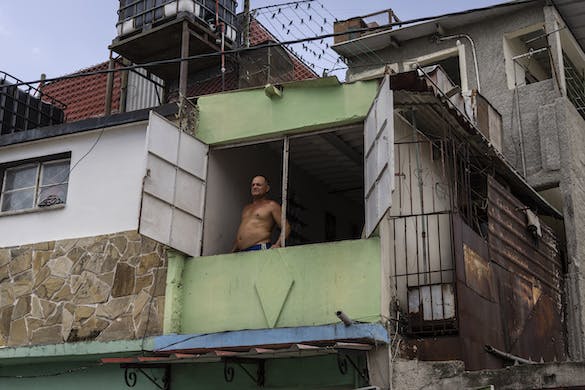Rolling Blackouts in Cuba Roil a Population Fleeced by the Communists
Just more than a year after a crackdown following unrest on the island, anti-government protesters are again taking to the streets.

With Cuba’s infrastructure collapsing, its currency in the dumps, and its Communist government unresponsive, the island’s mood is turning ever darker, with large street protests being held against government-ordered rolling blackouts.
Following anti-government protests in July 2021 — the largest since the 1959 Castro revolution — the regime blamed the unrest on America, while throwing hundreds in prison and forcing thousands to flee the island.
Apparently no longer intimidated, the protesters are now back. Mothers carrying babies are blocking Havana roads while hundreds chant anti-government slogans and carry placards that demand action to end the misery.
“In government stores you can’t even find aspirin,” the director of the Miami-based website Cuba Archive, Maria Werlau, told the Sun. “Buildings are crumbling on top of people, hospital ceilings are collapsing on patients,” the longtime researcher who focuses on documenting the island’s woes says. “People are waiting 14 hours in line to buy four lightbulbs for $50.”
Light bulbs, incidentally, are unavailable in peso-operated stores, where ordinary Cubans get their necessities. They can only be purchased in stores geared to Cubans with access to American dollars, which they get from the tourist economy, from remittances sent by American relatives — or if they have ties to Communist Party bigwigs.
Those who only have access to pesos lose out. “The best thermometer for measuring a country’s economic health is its exchange rate,” a Johns Hopkins University professor of applied economics, Steve Hanke, says. The Cuban peso, he tells the Sun, has depreciated by 65 percent against the greenback since September 2020, and 36 percent in 2022.
A specialist in global hyperinflation, Mr. Hanke says, “The Cuban peso is entered in my rogue’s gallery of junk currencies, which runs from the Venezuelan bolivar, which has lost 99 percent of its value against the greenback since January 2020, down to Iran’s rial and Ukraine’s hryvnia, which have lost 58 percent and 44 percent of their values, respectively, since January of 2020.”
Meanwhile, as soon as they get home, our lucky new light bulb owners realize that their hard-earned precious cargo is practically useless, as the island has for months suffered electricity outages that average at least five hours a day.
Until now the capital was spared, but Havana too must “share the burden, in solidarity with the rest of the country,” government propagandists announced recently. There is no obvious solution to the protest-inducing blackouts.
The blackouts “are not in solidarity, but rather a necessity to avoid a possible total collapse of the system,” the head of the University of Texas at Austin’s Latin America and Caribbean Energy and Environment Program, Jorge Pinon, told Reuters. Fires in two of Cuba’s 20 near-collapsing electric plants are taxing the country’s poorly maintained power grid, he said.
The electric grid is only part of the problem, Cuba Archive’s Ms. Werlau says. “The system is busted, it’s on life support, and the only hope is for a peaceful transfer to democracy.” Yet she can’t identify anyone in government who can bring about such change.
Alternatively, she says, Cuba can suffer the mayhem that characterized the early days after the collapse of the former Soviet republics — or, worse, the anarchy and criminality experienced in places like neighboring Haiti.
Since the 1960s Communist Cuba’s economy, like Blanche DuBois in “A Streetcar Named Desire,” depended on the kindness of strangers. After the collapse of its first sugar daddy, the Soviet Union, Cuba turned to Venezuela. At the height of the Castro-Chavez bromance in the early 2010s, Caracas’s subsidies to Havana amounted to $10 billion a year.
Now, Venezuela’s economy is in dire straits. Cuba’s largest foreign currency source is doctors it sends to fellow socialist governments at near-slavery terms. Mexico, for one, pays some $7,000 a month for each physician it imports from Cuba. The doctor gets about $200 of that sum, which is being posted in pesos — and only in Cuban banks, to deter defections.
Brazil has also long imported Cuban physicians — until President Bolsonaro expelled them. Now, Havana is hoping a former socialist president, Luis Lula Ignacio, wins the office again and renews the imports.
While the Cuban government confiscates the lion share of the fee it charges foreigners, exported doctors have it better than even the best medical specialists earn while working on the island. Those salaries average $40 a month, which will not buy a small bottle of aspirin. At the same time, government officials live in gated communities and drive fancy cars.
The legendary baseball broadcaster Vin Scully once summed it all up while covering a baseball game. “Socialism failing to work, as it always does, this time in Venezuela,” Scully said in an undated radio snippet that has been making the rounds on social media since his death last night.
“You talk about giving everybody something free, and all of a sudden there’s no food to eat,” Scully continued between pitches. “And who do you think is the richest person in Venezuela? The daughter of Hugo Chavez — hello. Anyway, 0 and 2.”

